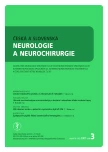Chiari Malformation: Own Experience
Authors:
Marek Sova
; M. Smrčka; V. Smrčka; G. Hanoun
Authors‘ workplace:
Neurochirurgická klinika LF MU a FN Brno
Published in:
Cesk Slov Neurol N 2007; 70/103(3): 304-307
Category:
Short Communication
Práce byla přednesena na 11. pracovních dnech chirurgie lební báze ve Dvoře Králové, 14. 9.–16. 9. 2006
Overview
The authors have presented results of an operative therapy of patients with Chiari malformation treated at the Department of Neurosurgery in University Hospital Brno since 1998 till now. A group of 13 patients, 11 women and 2 men with the average age of 52 years, was evaluated. The most cases were patients with Chiari malformation type I with or without syringomyelia. The most common symptoms included: headaches, brainstem, cerebellar and spinal symptoms. The report has emphasized the necessity of operative technique with sufficient bone decompression, dural decompression with duroplasty and then the restoration of the normal cerebrospinal fluid circulation by releasing arachnoid adhesions. The improvement in clinical symptoms is documented by the adjustment of radiological findings. The authors have discussed various alternatives of surgical approaches.
Key words:
Chiari malformation – syringomyelia – decompression
Sources
1. Cooke RS. Chiari malformations. In: Palmer JD, editor. Neurosurgery 96. Manual of Neurosurgery. New York: Churchill Livingston 1996: 680-4.
2. Chiari H. Ueber Veränderungen des Kleinhirns infolge von Hydrocephalie des Grosshirns. Dtsch Med Wochenschr 1891; 17: 1172-5.
3. Häckel M, Beneš V. Malformace zadního mozku 1. Přehled systematiky a etiologických teorií. Cesk Slov Neurol N 1996; 1: 21-32.
4. Gardner WJ. Hydrodynamic mechanism of syringomyelia: its relationship to myelocele.
J Neurol Neurosurg Psychiat 1965; 28: 247-59.
5. Williams B. On the pathogenesis of syringomyelia: a review. J Roy Soc Med 1980; 73: 798-806.
6. Alzate JC, Kothbauer KF, Jallo GI, Epstein FJ. Treatment of Chiari I malformation in patiens with and without syringomyelia: a consecutive series of 66 cases. Neurosurg Focus 2001 Jul 15; 11(1):E3. Available from: URL: http://www.ncbi.nlm.nih.gov/entrez
7. McGirt MJ, Nimjee SM, Fuchs HE, George (TM). Relationship of cine phase –contrast magnetic resonance imaging with outcome after decompression for Chiari I malformations. Neurosurgery 2006 Jul; 59(1):140-6; discussion 140-6. Available from: URL: http://www.ncbi.nlm.nih.gov/entrez
8. Häckel M, Beneš V, Mohapl M. Metodiky měření a monitorování tlaku likvoru při indikaci chirurgického řešení malformací zadního mozku. Soubor 25 nemocných. Cesk Slov Neurol N 2002; 3: 150-9.
9. Häckel M, Beneš V. Chiariho malformace bez myelodysplázie. Zkušenosti s léčbou 50 nemocných. Cesk Slov Neurol N 2004; 5: 370-6.
10. Greenberg MS. Handbook of Neurosurgery. New York: Thieme 2001.
11. Šteňo J, Biksadský P, Matejčík V, Krist J. Chirurgické liečenie syringomyelie pri Chiariho malformácii u dospelých. Cesk Slov Neurol N 2000; 3: 162-6.
Labels
Paediatric neurology Neurosurgery NeurologyArticle was published in
Czech and Slovak Neurology and Neurosurgery

2007 Issue 3
- Metamizole vs. Tramadol in Postoperative Analgesia
- Memantine in Dementia Therapy – Current Findings and Possible Future Applications
- Memantine Eases Daily Life for Patients and Caregivers
- Metamizole at a Glance and in Practice – Effective Non-Opioid Analgesic for All Ages
- Advances in the Treatment of Myasthenia Gravis on the Horizon
Most read in this issue
- Chiari Malformation: Own Experience
- Osmotic Demyelination Syndrome – MRI Diagnosis: a Case Report
- The Brain MR Imaging in Patients with Myotonic Dystrophy DM 1
- Osteoplastic Decompressive Craniotomy
